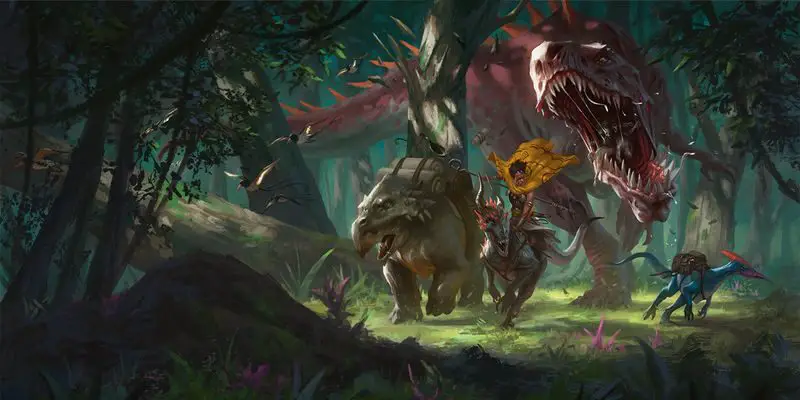Art by atomiiii, CC Attribution-Noncommercial-No Derivative Works 3.0 License
We all know well the awkward atmosphere surrounding first-time players. Between learning rules and discovering what a character can even do in Dungeons and Dragons, role playing is the last thing on a new player’s radar.
But we also know well the rush that comes from a cohesive, successful, and immersive adventure. Once a player experiences that first dose of heroism by her own choices and ingenuity, she’s hooked.
As Dungeon Masters, if we can just get our players to that level, we can run a successful campaign. But getting players to role play is hard work, especially when they feel emphatically ashamed.
In our experiences as DM’s, Flutes and I have developed a list of tips to help you encourage your players to start role playing, or to role play on a more fulfilling level.
Without further ado, let’s go through ten tips for helping players learn to role play.
1. Start with healthy expectations.
It’s okay to start your first adventure with a prelude moment where you discuss expectations. Assure your players up front that everyone can and should role play without feeling silly. Everyone will feel silly at times, but nobody will judge, because you’re all committed to doing it together.
It’s harder to start role playing in a campaign when you’ve spent the first few sessions not role playing, so start off right by encouraging everybody to role play.
2. Get comfortable role playing with a pre-game game.
In his spare time, Flutes is an expert improvisational comedian. His advice is that sometimes it’s easier to start role playing in a new, sometimes intimidating setting when you’ve practiced role playing in a low-stakes context.
One game to facilitate role playing that you and your players could play before actually starting the campaign is called “party quirks.” This game is often played on Whose Line Is It Anyway and should take no more than 10 minutes.
Party Quirks
One person (other than the Dungeon Master, as you will be running the game) will be a guesser while the other players take on quirks or personas that only they and the other non-guessing players know.
Some quirks could include:
- A Wet Cat Trying to Get Warm
- A 13 Year Old Girl Obsessed with the Hotness of The Avengers
- A Tall Man Afraid of Heights
- A Neat Freak Obsessed with Tidying Up
- A Homeless Man Stocking Up for His Next Meal
Keep in mind that you don’t want to take up too much time, as this is just an exercise to get everyone to open up a little.
Once everybody (except the guesser) has their secret quirk, they “exit the stage” and the guesser is brought on. The guesser then pretends to be setting up and hosting a party. One-by-one, quirky party guests will arrive and act how they would with that quirk, and the guesser will try to guess what the quirk is.
The party guests should enter about every 30 seconds or less, so there can be multiple unknown party guests in the scene at once.
Once the party host guesses or closely guesses the quirk, that party guest makes an excuse to leave the party and is done!
If this goes on for more than a few minutes with little success, the Game Master can give some hints, or maybe just put the whole thing on a timer (5-10 minutes) and then reveal the quirks at the end.
What’s the advantage to playing this game? Everybody will be more comfortable with each other and with themselves. They’ve already role played in front of these new people, so roleplaying their characters will be a breeze. Also, this game coaches them to invent character traits that are easy to role play.
3. Encourage players to speak in the first person as their characters (active vs passive voice).
When I started playing Dungeons and Dragons, I spoke passively about my character. “My character asks this NPC about the thing.” This gave me a buffer to be involved in the game without actually role playing, which I found embarrassing.
My Dungeon Master, Flutes, encouraged me to speak as the character instead of in third person. As soon as I broke this habit, role playing became easy. Now, as my character, I say “Would you, good NPC sir, tell me about the thing?”
4. Role play NPCs as the Dungeon Master.
When you mix new and experienced players, first-time players will pick up role playing faster because they have great examples in front of them (the other players and, hopefully, the Dungeon Master). The more people you slowly get on board role playing, the easier it’ll be for others to start.
However, if a Dungeon Master starts a game with all brand-spanking-new players who have never played a tabletop role playing game before, it is absolutely imperative that the Dungeon Master starts off role playing every single non-player character.
You’re running the game, so it’s your job to give them good examples of role playing so that they don’t feel like they’re talking to an inanimate object.
5. Address characters by name.
This advice is for the Dungeon Master as well as players. At the beginning of the campaign, make everyone’s name known and familiar, and encourage your players to address each other by their characters’ names.
Some ways to facilitate name-remembering: set up name tags in front of the players, invite players to write down players’ character names, make up a bardic song about the adventurers that includes the names.
When a player speaks to another player using his or her character name, the world becomes more immersive, and it becomes easier to role play.
6. Put character pictures in front of players along with name tags.
Like a mask, people will feel more comfortable to break from their shell if they know they’ve got a new face to go with the act. This will also help players engage more easily with the players around them, character to character.
7. Encourage player-characters to speak to other player-characters.
Players, in character, should find moments throughout the campaign to address and speak to other player characters. As players find commonalities between other player characters, they can talk about it in character.
Allow for some downtime for players to chat. Or, set up situations where they have to chat. Encourage them to interact by setting up a situation, such as: “Grog, you notice Penelope has a bit of limp. Do you wish to talk to her about it in character?” A prompt can go a long way in role playing.
8. Give them tips on how to role play in the moment.
Without inciting their pride, if a player is speaking in the third person or maybe addresses a player instead of the player’s character, ask the player to speak as his character. This will remind them to role play without, hopefully, angering or offending them.
9. Eventually, encourage players to develop a character voice.
Voices can be difficult, but are one of the best ways to keep players role playing.
Deciding on a voice is the first challenge, then figuring out how to keep it up is the other. Invite players to emulate a character on screen if they find this challenging. They can always add in their own quirks and characteristics, but starting off with a template is the easiest way to get started and to stay in character.
Choosing a voice before playing a character is almost as important as developing a character, as it’s hard to start role playing a voice after a character is established.
10. Add catchphrases and specific character traits to the role playing.
The thing about role playing is that the weirder or funnier, or more unique, a character is, the easier it can be to role play him.
For example, I played a chibi-style Druid named Sakura. I drew different pictures of her with different emotions that I would display in front of me depending on my mood. I downloaded anime reaction noises that Sakura would “minor illusion” cantrip to fit a situation. I developed a stereotypical high-pitched and enthusiastic voice with silly body language like Peace-Sign-Wink or Shake-Fist-at-Player. I wrote down catchphrases that I could throw in whenever I had a hard time role playing.
Overall, Sakura has been my favorite character to role play because I had specific guidelines to follow, and I knew I could be over-the-top and still in-character. She also kicked butt in many of the battles, so my love for Sakura-chan grew immensely.
Bonus: For the bold, add in costumes.
This tip is not for everyone. But sometimes, immersion into a character can happens because a person physically resembles that character. If it works for your players, you might as well let them go for it unabashed.
Conclusion
Whether you’re DMing for a group of new players or helping experienced players play the game with greater immersion, coaching your players to role play is one of the keys to a successful campaign.
Do you have any additional suggestions for helping players role play? What successes have you seen? Let us know in the comments!




